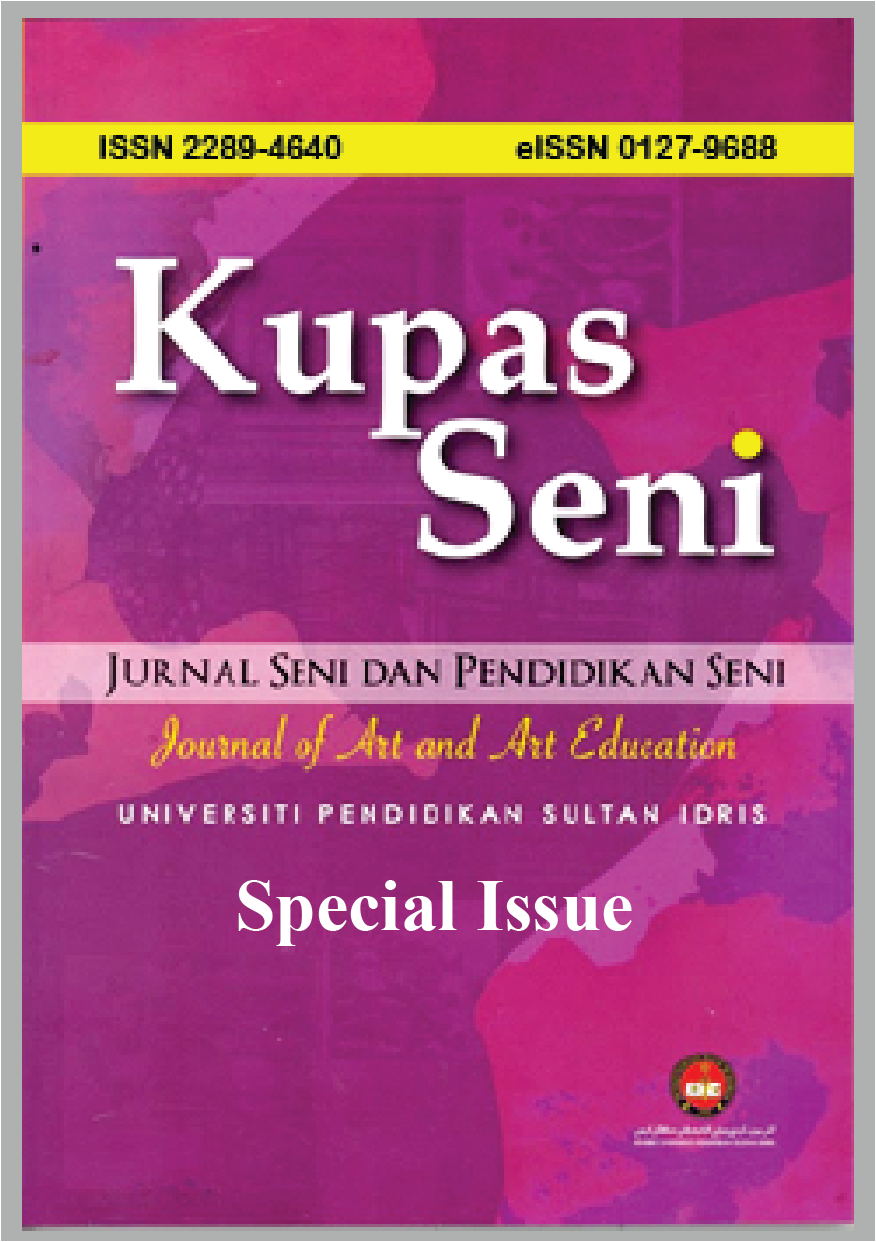Visual Arts in the Context Of Post COVID-19 in Malaysia: Interpretation of Symbols for selected Artworks “Transit 1X1: Online Exhibition”
DOI:
https://doi.org/10.37134/kupasseni.vol10.sp.2.10.2022Keywords:
Symbol, visual art, post COVID-19Abstract
Painting can be used as a communication medium to explain an event or to express the meaning by visual art using a storytelling framework that involves ideas, style, and meaning. Painting is an art form that allows the artist to capture their thoughts and feelings through visual images that are then transformed into works of art. Along with this ability, the artist is also able to convey their feelings through their paintings. The study conducted by the researcher came to conclusion that the Covid-19 event that took place at that time influenced society. The study also found that artists were influenced by the event, particularly regarding the progression of life in the areas of social life, culture, economy, politics, psychology, technology, and communication. Artists started producing works that reflected their own experiences or viewpoints that revolved around the events that took place during the Covid-19 pandemic because of the ramifications of the events that took happened. This artwork is a selection from the exhibition Transit 1x1: Online Exhibition. The purpose of this study is to analyze and understand the form and meaning of the symbols used in the works of painting by Husin Othman, Shafiq Nordin, and Aimi Atikah Roslan in the post Covid-19 context in Malaysia. These paintings were created by Husin Othman, Shafiq Nordin, and Aimi Atikah Roslan. This study makes use of qualitative research methods, such as observation, documentation, and interviews with artists. These approaches are employed in the collecting of data for this study. As a result of the analysis of this study, the researcher found that the symbols used by each of these artists clearly show the use of self-expression against the phenomenon that occurred during the Covid-19 event. This was found to be the case because the symbols clearly show how the artists were reacting against the phenomenon. In conclusion, the works that this painter has produced use a variety of symbols as a medium of expression to convey the message that is intended to be conveyed through the artwork.
Downloads
References
Badrul, R. A. H., & Nur, H. I. (2020). Analisis Dekonstruktif Terhadap Satira Sosiobudaya dan Politik dalam Filem Lelaki Harapan Dunia (2014). Diperoleh semula daripada http://journalarticle.ukm.my/16085/1/42730-137341-1-PB.pdf
Belinda, S. D., & M, A. R. (2018). Kajian Lukisan Still Life Jelekong. Penerbitan dalam talian Doi: http://dx.doi.org/10.26742/atrat.v6i1.574
Berita Harian. (2020). Kronologi COVID-19 di Malaysia. Diperoleh semula daripada http://www.bharian.com.my/nasional/2020/03/666122/kronologi-covid-19-di-malaysia.
Berita Harian. (2021). COVID-19 Beri Impak Kesihatan Mental - Dr Noor Hisham. Diperoleh semula daripada https://www.bharian.com.my/berita/nasional/2021/09/862185/covid-19-beri-impak-kesihatan-mental-dr-noor-hisham
Berita RTM. (2022). Kumulatif Kes COVID-19 di Malaysia menceccah 4, 524 727. Diperoleh semula daripada https://berita.rtm.gov.my/index.php/covid-19/41615-kumulatif-kes-covid-19-di-malaysia-mencecah-4-524-727.
Danang, N. D. F. A., & Abiyasa, D. P., (2021). Fenomena Badut Sedih : Sebuah Kajian Stakeholder Theory JIP (Jurnal Industri dan Perkotaan) Volume 16 Nomor 2/Agustus 2020.
Fariz, S. A. (2018). Warna dan Psikologi. Diperoleh semula daripada http://www.myhealth.gov.my/warna-dan-psikologi/
Eizah Mat Hussain. (2019). Simbol dan Makna Dalam Pantun Melayu. Kuala Lumpur:Intitut Terjemahan & Buku Malaysia Berhad.
Issarezal, I. (2021). Mesej Simbolik Di Sebalik Karya Seni Visual Bertajuk Wira Oleh Haris Abadi Abd Rahim Dalam Konteks Fenomena Covid-19. Universiti Malaysia Sabah: Akademi Seni dan Teknologi Kreatif Penerbitan dalam talian Doi: https://doi.org/10.51200/ejk.vi.3671
Junaidi, M. & Mohd, A. Ra. A. R. (2020). Cabaran dan Strategi Pasca-Pandemik Untuk Belia. Kuala Lumpur.
Khazanah Research Institute Kementerian Kesihatan Malaysia (2022). Covid-19 terkini. Diperoleh semula daripada https://covid-19.moh.gov.my/info-terkini/covid-terkini
Liza, M. M. Noh., Hamdzun, H., & Jasni, D (2015). Analisis Formalistik Dalam Memaknai Simbol Budaya Melayu. Diperoleh semula daripada doi.org/10.47252/teniat. v3i2.323
Maria, K. (2014). Kajian Tentang Simbol Batik Semen Rama Bagi Kehidupan Masyarakat Jawa. Diperoleh semula daripada Doi: https://doi.org/10.15294/teknobuga.v1i2.6411
Mimi, S. (2021). Kisah Pandemik Melakar Khazanah Seni di Transit 1 x 1. Diperoleh semula daripada https://baskl.com.my/kisah-pandemik-melakar-khazanah-seni-di-transit-1-x-1/
Mohamed, N. R. M. A., & Muhammad, W. R. (2020). Pandemik Dalam Karya Sastera: Ceritera Ceritera Kehidupan Manusia. Malaysia: Universiti Utara Malaysia
Tjetjep, R. R. (2011). Metodologi Penelitian Seni.Indonisia:Penerbit Cipta Prisma Nusantara Semarang.
Tresno, S. (2021). 10 Teknik Meditasi Untuk Kesehatan Jiwa Dan Raga. Indonesia: Tiramed
Downloads
Published
Issue
Section
License
Copyright (c) 2022 Rosmidahanim Razali, Wan Nurhasyimah W. Mohd Apandi, Hilal Mazlan, Syed Alwi Syed Abu Bakar, Mohd Nafis Saad

This work is licensed under a Creative Commons Attribution-NonCommercial-ShareAlike 4.0 International License.





